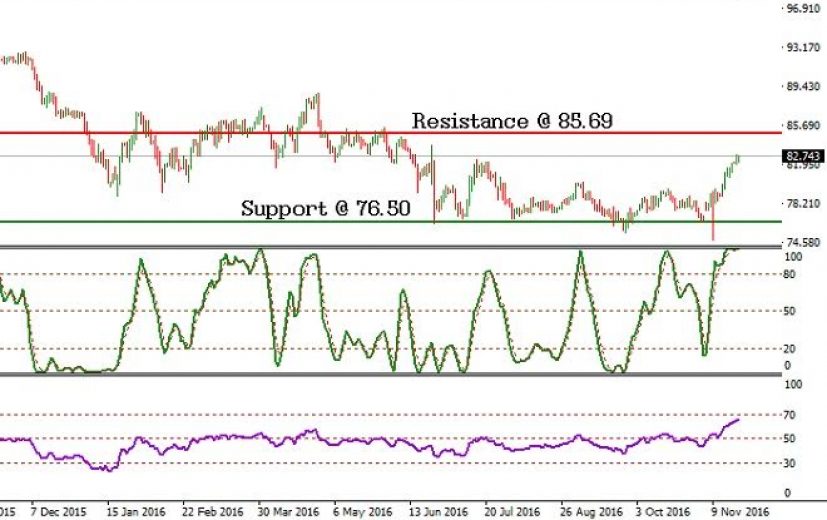 The Canadian dollar turned weak during the period ranging from mid-October to mid-November. There were two reasons for the weakness. Obviously, the first reason is the Canada’s economic contraction in the second-quarter.
The Canadian dollar turned weak during the period ranging from mid-October to mid-November. There were two reasons for the weakness. Obviously, the first reason is the Canada’s economic contraction in the second-quarter.
The second reason is the call for the renegotiation of the NAFTA agreement by the then US Presidential candidate Trump.
On the other hand, the uncertainty created due to the US Presidential election supported the strengthening of the Yen. Anticipating the CAD/JPY pair to decline, we had recommended going short near 78.40, with an order to book profit at 76.40.
In line with the recommendation given to the currency traders, we had suggested binary traders to invest in a one touch put option. In two weeks’ time, the trade resulted in a profit. The CAD/JPY pair, which reversed after hitting a low of 74.80, is now trading at 82.60 levels. The reasons below explain why the CAD/JPY pair would again start declining in the weeks ahead.
RT
The Canadian dollar mainly strengthened due to the anticipation of a deal among the OPEC members to freeze or cut production in order to stabilize the crude prices. The OPEC meeting is scheduled to take place in about two weeks’ time. Russia, which recorded a two and a half decade high production of 11.2 million barrels per day, is also willing to support the deal by freezing the output as long as the intended production cut of OPEC materializes.
However, it may take a long time for the production cut to impact the spot prices. Furthermore, prices would recover only if the supply glut is removed and the demand starts rising. A rise in the price of any commodity based on supply disruptions can never last long. Additionally, the Canadian dollar no longer shares a high degree of correlation with the price of crude oil. So, the price of crude should firm up above $55 for the Canadian dollar to turn bullish in the medium-term chart.
The Statistics Canada also reported that the unemployment rate in Canada remains high at 7% in October. The trade deficit more than doubled to C$4.1 billion in October, from C$1.99 billion in September. The victory of Trump has also put the NAFTA agreement on a question mark.
In the case of Japan, the economy expanded 0.5% q-o-q in the quarter ended September. The jobless rate declined to a 21 year low of 3% in September. Considering the recent weakness, the BoJ is not expected to consider any new measures to weaken the Yen. Furthermore, considering the recent fall of the Yen, we can anticipate a short covering to begin soon. On the basis of the details provided above, we anticipate the CAD/JPY to undergo a correction soon.
Technically, the CAD/JPY pair is expected to face heavy resistance at 85 levels. The stochastic oscillator, with a reading of about 100, indicates that there is a high probability of a correction in the pair. Thus, a currency trader can open a short position in the CAD/JPY pair near 83.30 levels. To limit losses, a stop loss order can be placed above 85. The short position can be covered when the CAD/JPY pair drifts down to 80.50.
Purchasing a one touch put option would allow a binary trader to benefit from the predicted decline of the CAD/JPY pair. The suggested target level for the put option is 81.50. Likewise, a four week time period should be allowed for the expiry of the contract.





